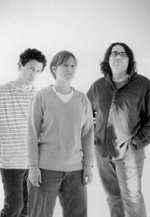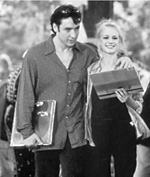AS CELEBRITY COUPLES go, Georgia Hubley and Ira Kaplan are no Tom Cruise and Nicole Kidman. They’re not surrounded by speculation that one of them may or may not be able to breed properly, nor are they written up in Variety for being difficult to work with. But like Kidman-Cruise, Inc., when Hubley and Kaplan—who are two-thirds of Yo La Tengo—get naked, people start talkin’. Word has it the beloved trio’s new album And Then Nothing Turned Itself Inside-Out (Matador) is so thematically rich with buried love letters and secret spats between the band’s lovebirds, they might as well be standing in front of the indie rock masses with hastily placed fig leaves.
Yo La Tengo
King Cat Theater, Tuesday, March 7
This makes Yo La drummer Hubley sigh. She’s busy rattling around her space in Manhattan, where she’s trying to stay on the line in between call-waiting beeps, most of them adding another task to the group’s pre-tour checklist. Right now, fielding questions about her marriage to YLT singer-guitarist Kaplan is furthest from her current frame of logic. But between And Then Nothing‘s audible sweet nothings and the press surrounding the long-awaited follow-up to 1997’s I Can Hear the Heart Beating as One, it’s starting to be tagged as a concept album about their wedding vows.
“I don’t really care that people talk about the me and Ira thing,” Hubley offers. “The thing that bugs me most is the exclusive attention. This band has been together for a long time with the same three people. I find it frustrating that it’s not seen as me and Ira and James.”
Hubley, Kaplan, and bassist James McNew have made an undeniable impact on modern music lovers—together. It’s just that so much waiting time between the omniscient, hazy rock record that was I Can Hear the Heart and the incredibly soft, sentimental affair that is the new record creates a lot of undue pressure—pressure to answer questions, mainly. Never has a Yo La Tengo album been so palpably unhip: You can drink Chianti to these songs without one surprise beat causing an unpleasant blip in your wine glass. It’s daring in its lack of cooler-than-thou chords, its lovable low blood pressure. You can even hear most of the lyrics, perhaps the biggest factor working for the marriage-as-concept-album crowd.
ALBUM OPENER “Everyday” is founded on YLT’s brain-tingling guitar buzz, but it quickly builds into an oceanic field of percussion (courtesy of Manhattan avant jazz pro Susie Ibarra) that sets the tone for “Our Way to Fall,” which could easily tell the courtship story that’s got everyone all aflutter. Reminiscent of the classy keyboard confessional “Autumn Sweater,” Ira sounds like a schoolboy, whispering “I remember walking up to you/I remember my face turned red/I remember staring at my feet.” And Then Nothing is filled with these magically quiet moments, pretty with feverish unknowns. In somewhat chronological order, the relationship ebbs and sparks as the disc spins onward. By track six, we’ve got the first fight song, “The Crying of Lot G.” A spoken word affair, Ira mews, “All we do is fight . . . you don’t wanna listen/I can’t shut up . . . it isn’t always this way.” Soon, the storm clears and the Everly Brothersstyle ballad “Tears Are in Your Eyes” delivers a needed crack to the jaded heart. The album closes with the 17-minute “Night Falls on Hoboken,” an organic and peaceful orchestration that could be likened to a happy domestic partnership—if one wanted to stretch that far.
Personal or not, Hubley knows And Then Nothing is something special. “There is an element of intimacy here,” she concedes. “The lyrics are more direct and intimate, but it’s a mood created from the three of us thinking for so long what this record would be.” For almost a year, the trio recorded tons of cassettes with experimental drumbeats, added strings, and tried a less guitar-centric sound. “We’d get together and end up playing very formless—I know ‘formless’ sounds negative, but I mean it in a positive way—music,” Hubley says. Without a definite deadline, they were free to weed down the loose jams they’d created. In the middle of a blistering summer, they headed into Nashville studio Alex the Great (where 1995’s Electr-O-Pura was recorded) to construct And Then Nothing‘s audibly wintry feel. Hubley blames it on the studio’s air-conditioning unit.
Despite its loyalty to trio-dom, Yo La Tengo will arrive in Seattle as a quintet, with musician pals Mac McCaughan (of Superchunk) and David Kilgour (of the long-running Australian band the Clean) in tow. The five plan on trading instruments and general merriment for this show, where it will be difficult to assign concepts, even to well-known YLT songs. For one of music’s coolest couples, it’s an opportunity to cover that naked feeling with a warm winter coat.







